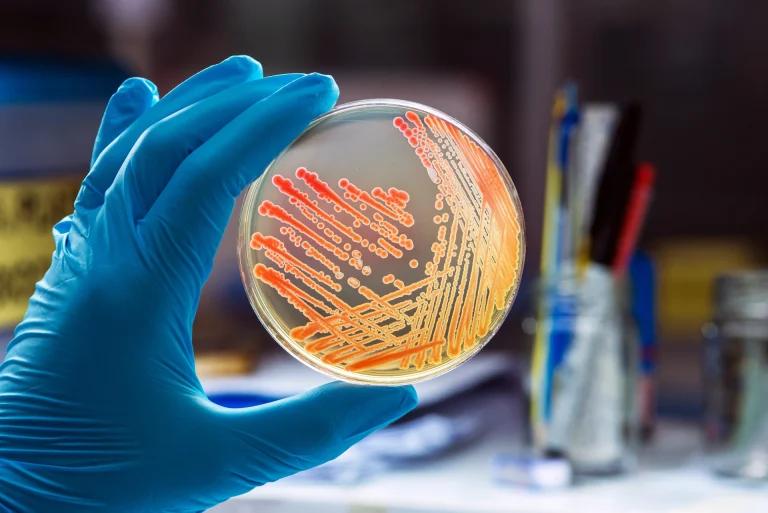E. coli, a common bacterium found in the human gut, is often associated with unpleasant digestive issues. However, the true dangers of this microorganism extend far beyond the discomfort of diarrhea and vomiting. Certain strains of E. coli can cause life-threatening harm.
In this article, we will look into the complex world of E. coli infections, exploring the various types, their symptoms, causes, and the potential for fatal outcomes.
Understanding E. coli
E. coli, or Escherichia coli, is a diverse group of bacteria that can be found in the intestines of both humans and animals. While many strains of E. coli are harmless and even play a beneficial role in digestion, certain variants can cause severe illness and, in some cases, lead to life-threatening complications.
Different strain types of E. coli
E. coli infections can be categorised into several distinct types, each with its own unique characteristics and potential for harm. Some of the most notable strains include:
- Shiga Toxin-Producing E. coli (STEC): This strain, also known as enterohemorrhagic E. coli O157:H7, is renowned for its ability to produce a potent toxin called Shiga toxin. STEC infections are often associated with severe, bloody diarrhea and can progress to the potentially fatal condition known as hemolytic uremic syndrome (HUS)
- Enterotoxigenic E. coli (ETEC): ETEC is a common cause of traveler’s diarrhea, a condition that can affect individuals visiting developing countries with poor sanitation. This strain of E. coli produces toxins that disrupt the normal functioning of the intestines, leading to rapid-onset diarrhea
- Uropathogenic E. coli (UPEC): While most E. coli infections manifest in the gastrointestinal tract, UPEC is a strain that can invade the urinary tract, causing painful and potentially dangerous urinary tract infections (UTIs)
- Other Strains: Additional strains of E. coli, such as enteropathogenic E. coli (EPEC), enteroaggregative E. coli (EAEC), and enteroinvasive E. coli (EIEC), can also contribute to various gastrointestinal ailments, with varying severity
Understanding the distinct characteristics of these E. coli strains is crucial in recognising their potential risks and developing appropriate prevention and treatment strategies.
Symptoms of E. coli infections
The symptoms and potential complications associated with E. coli infections can vary widely, depending on the specific strain and the individual’s immune response.
Gastrointestinal symptoms
The most common manifestation of E. coli infection is the development of gastrointestinal symptoms. These can include:
- Watery, sometimes bloody diarrhea
- Severe abdominal cramps and pain
- Nausea and vomiting
- Low-grade fever
The severity and duration of these symptoms can range from mild and short-lived to severe and prolonged, depending on the strain of E. coli involved.
Urinary tract infections
When E. coli breaches the urinary tract, it can lead to a range of troubling symptoms, including:
- Painful, burning sensation during urination
- Frequent or urgent need to urinate
- Cloudy, foul-smelling urine
- Lower abdominal or pelvic discomfort
These UTI-related symptoms can be particularly concerning, as they may indicate a deeper infection that requires prompt medical attention.
Serious complications
In some cases, E. coli infections can progress to more severe, potentially fatal complications. These infections can lead to severe, life-threatening complications, including:
- Hemolytic uremic syndrome (HUS): This condition, which can result from STEC infections, can cause kidney failure, neurological problems, and even death
- Sepsis: A systemic inflammatory response to the infection that can lead to organ failure and shock, with a mortality rate ranging from 8% to 35%
Individuals with weakened immune systems, such as the elderly or those with underlying health conditions, are particularly susceptible to these life-threatening complications.
Causes of E. coli infections
Understanding the various ways in which E. coli can be transmitted and the factors that increase the risk of infection is crucial for prevention and mitigation.
Modes of transmission
E. coli infections typically spread through the faecal-oral route, where the bacteria from contaminated surfaces, food, or water find their way into the mouth and digestive system. Some of the most common modes of transmission include:
- Consuming undercooked meat such as ground beef, unpasteurised dairy products or contaminated produce
- Drinking contaminated water, such as from untreated sources or improperly sanitised swimming pools
- Failing to wash hands thoroughly after using the restroom or coming into contact with infected individuals or animals
- Exposure to farm animals, petting zoos, and other settings where animals are present can also lead to E. coli infections, as the bacteria can be present in the animals’ feces and environments
In addition, E. coli can also be transmitted through direct contact with infected individuals or contaminated surfaces, highlighting the importance of proper hygiene and sanitation practices.
Risk factors
Certain individuals and groups are at a higher risk of developing severe E. coli infections and their associated complications. These include:
- Young children and the elderly: Individuals at the extremes of age tend to have weaker immune systems, making them more vulnerable to the harmful effects of E. coli
- Individuals with compromised immune systems: Those with underlying health conditions, such as HIV/AIDS, cancer, or those taking immunosuppressive medications
- Individuals with chronic conditions: Conditions like diabetes, inflammatory bowel disease, and kidney disease can also heighten the risk of severe E. coli infections
- Travellers to developing countries: Individuals visiting regions with poor sanitation and water treatment facilities are more likely to encounter ETEC and other diarrheagenic strains of E. coli
Recognising these risk factors can help individuals take the necessary steps to protect themselves and seek timely medical attention if symptoms arise.
Diagnosis and testing for E. coli infections
Accurately diagnosing an E. coli infection is crucial for determining the appropriate course of treatment and monitoring the progression of the illness.
Diagnostic tests
Healthcare providers may utilise a variety of tests to identify the presence of E. coli and determine the specific strain responsible for the infection. These tests include:
- Stool culture: A sample of the patient’s stool is collected and analysed in a laboratory to identify the presence of E. coli bacteria
- Urine culture: For infections affecting the urinary tract, a urine sample may be tested to detect the presence of E. coli
- Blood culture: In severe cases, a blood sample may be taken to check for the presence of E. coli in the bloodstream, which could indicate a systemic infection
- Molecular testing: Advanced techniques, such as polymerase chain reaction (PCR) tests, can be used to detect the specific genetic markers of E. coli strains, including those associated with the production of Shiga toxin
The choice of diagnostic test will depend on the patient’s symptoms and the suspected location of the infection.
Treatment for E. coli infections
The approach to treating E. coli infections varies depending on the severity of the symptoms and the specific strain of the bacteria involved.
Supportive care for gastrointestinal infections
For many E. coli-related gastrointestinal infections, such as those caused by ETEC or mild STEC strains, the primary focus is on providing supportive care to alleviate symptoms and prevent dehydration. This may include:
- Maintaining adequate hydration through the consumption of fluids, electrolyte-rich solutions, or intravenous (IV) fluids if necessary
- Avoiding the use of antidiarrheal medications, as they can potentially worsen the infection
- Providing over-the-counter pain relievers to manage abdominal discomfort
In these cases, healthcare providers typically refrain from prescribing antibiotics, as they can increase the risk of complications like HUS in STEC infections.
Antibiotic treatment
For certain E. coli infections, such as those affecting the urinary tract or bloodstream, or in cases of severe systemic illness, healthcare providers may prescribe antibiotics. The specific antibiotic choice will depend on the strain of E. coli involved and the patient’s response to treatment. Common antibiotics used to treat E. coli infections include:
- Trimethoprim-sulfamethoxazole (TMP-SMX)
- Ciprofloxacin
- Nitrofurantoin
It is important to note that the use of antibiotics in STEC infections remains controversial, as they can potentially exacerbate the release of Shiga toxin and increase the risk of HUS.
Specialised interventions
In cases of severe E. coli infections, particularly those involving STEC and the development of HUS, healthcare providers may need to employ more specialised interventions, such as:
- Dialysis: To support kidney function in the event of renal failure
- Blood transfusions: To address the destruction of red blood cells
- Supportive care in an intensive care unit (ICU): To closely monitor and manage life-threatening complications
These interventions are typically reserved for the most severe and life-threatening E. coli infections, underscoring the importance of early recognition and prompt medical attention.
Preventing E. coli infections
Preventing E. coli infections is crucial, as these bacteria can pose a significant threat to individual and public health. By implementing a range of preventive measures, individuals and communities can reduce the risk of contracting these potentially deadly infections.
Personal hygiene
One of the most effective ways to prevent E. coli infections is to maintain proper personal hygiene and sanitation practices. This includes:
- Thorough handwashing with soap and water, especially after using the restroom, before handling food, and after contact with animals or contaminated surfaces
- Avoiding the preparation or consumption of undercooked meat, unpasteurized dairy products, or unwashed produce
- Ensuring proper cleaning and disinfection of surfaces, utensils, and food preparation areas
Food safety measures
Proper food handling and preparation are critical in preventing E. coli infections. Recommended practices include:
- Cooking meat, poultry, and seafood to the appropriate safe internal temperatures. Avoiding consumption of high-risk foods, such as unpasteurized dairy products (raw milk) or undercooked meat
- Avoiding the cross-contamination of cooked foods with raw meat or poultry
- Refrigerating perishable foods at the appropriate temperatures and discarding any that have been left at room temperature for an extended period
- Thoroughly washing all fruits and vegetables before consumption
- Maintaining meticulous hand hygiene and food safety practices. Use hot soapy water on knives, countertops and cutting boards. Separate cutting boards for raw meat and food
Water safety
Ensuring the safety of water sources is another essential component of E. coli prevention. This includes:
- Drinking only water that has been properly treated and disinfected, either through municipal water systems or personal water purification methods
- Avoiding swimming or wading in bodies of water that may be contaminated with animal or human waste
- Properly maintaining and disinfecting private wells, swimming pools, and other water sources
By adopting these preventive measures, individuals and communities can significantly reduce the risk of E. coli infections and their potentially devastating consequences.
Conclusion
E. coli can harbour a deadly potential that extends far beyond the discomfort of digestive issues. Understanding the diverse strains of this microorganism, their symptoms, causes, and the risk of life-threatening complications is crucial for safeguarding individuals and public health.
Sources
Medical Disclaimer
NowPatient has taken all reasonable steps to ensure that all material is factually accurate, complete, and current. However, the knowledge and experience of a qualified healthcare professional should always be sought after instead of using the information on this page. Before taking any drug, you should always speak to your doctor or another qualified healthcare provider.
The information provided here about medications is subject to change and is not meant to include all uses, precautions, warnings, directions, drug interactions, allergic reactions, or negative effects. The absence of warnings or other information for a particular medication does not imply that the medication or medication combination is appropriate for all patients or for all possible purposes.








